Biblical figure Jael's act of bravery or betrayal, depending on perspective, changes a nation's fate, leaving readers questioning the limits of duty and honor.
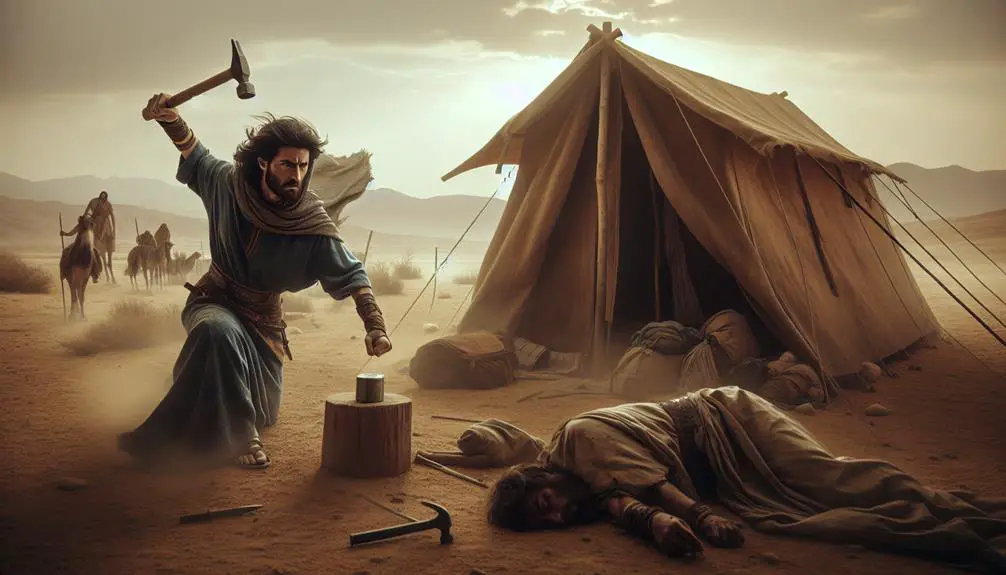
What Did Jael Do in the Bible
In the tapestry of biblical narratives, Jael's story stands out as a thread woven with courage and intrigue. You might find yourself puzzled by the actions of this seemingly ordinary woman who played a pivotal role in the conflict between the Israelites and their oppressors.
Jael's hospitality towards Sisera, the fleeing enemy general, quickly morphs into an act of audacious bravery that you wouldn't expect at first glance. But what drives a person to such extremes, and what can her story teach us about morality, faith, and survival?
To unravel the complexities of Jael's character and her controversial deed, one must look closer at the fabric of her story.
Key Takeaways
- Jael cunningly defeated Sisera, a Canaanite commander, by driving a tent peg through his head while he slept in her tent.
- Her actions played a critical role in Israel's struggle against Canaanite oppression during the Judges era.
- Jael's defiance of traditional gender roles showcased her as a figure of courage and strategic boldness in ancient warfare.
- The story of Jael prompts discussions on ethics, gender roles, and divine justice in the context of wartime necessity and cultural norms.
The Setting of Jael's Story

Jael's story unfolds against the backdrop of ancient Israel's struggle for survival and autonomy, during the period of the Judges. This era, marked by decentralized leadership and frequent conflicts with neighboring peoples, sets a crucial stage for understanding her actions and their significance. The geographical context of this narrative is pivotal, encompassing the varied landscapes of ancient Canaan, where city-states and tribal territories were continuously contested. These lands, ranging from fertile plains to rugged mountains, not only shaped the daily lives of their inhabitants but also the strategies of warfare and diplomacy that underpinned their interactions.
Within this setting, cultural norms played an equally vital role. Society was predominantly patriarchal, with men occupying most leadership roles, yet women like Jael emerged in narratives as key figures, shaping events through their actions. Hospitality norms, deeply ingrained in the culture, required individuals to offer protection and sustenance to guests, a practice that could override existing social and political allegiances. This expectation of hospitality adds layers of complexity to Jael's story, illustrating the tension between cultural imperatives and personal or tribal loyalty.
Moreover, the period of the Judges was characterized by a cyclical pattern of apostasy, oppression, deliverance, and peace among the Israelites, a cycle that reflects the tumultuous relationship between different tribes and their neighbors. Jael's story, embedded within this turbulent historical and cultural context, offers insights into the intricate dynamics of power, faith, and survival that defined the era.
Who Was Jael?
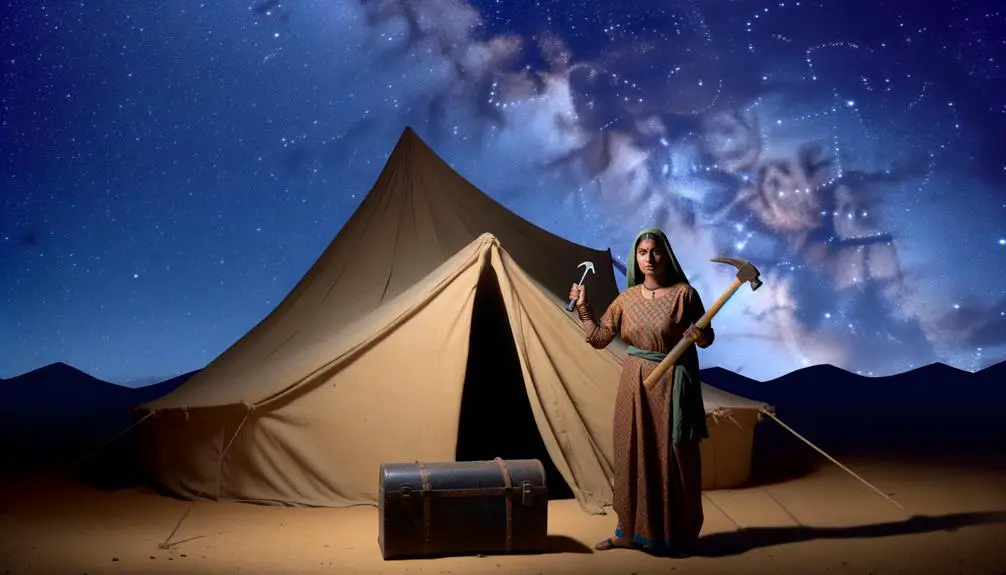
You might wonder who Jael was beyond the brief mentions in biblical texts. Her background and family provide a context that's crucial for understanding her actions and their significance in history.
Exploring Jael's role and legacy reveals the complex dynamics of her time and offers insights into her character's impact on religious and cultural narratives.
Jael's Background and Family
Delving into the biblical narrative, one encounters Jael, a figure whose familial ties and background illuminate her pivotal role in the story of Israel. Jael was married to Heber the Kenite, aligning her with the Kenite nomads. This group, known for their metalworking skills, maintained neutrality amidst the turbulent Canaanite alliances.
The Kenites' strategic decision to distance themselves from the Canaanite city-states allowed them to navigate the complex socio-political landscape of the time. Jael's heritage and marital connection positioned her uniquely, bridging the worlds of the Israelites and the surrounding Canaanite peoples. Her background sheds light on the intricate network of alliances and enmities that characterized the ancient Near East, framing her actions within a broader geopolitical context.
Jael's Role in History
In the annals of biblical history, Jael emerges as a figure of cunning and resolve, playing a pivotal role in the narrative of Israel's struggle against Canaanite oppression. Her actions not only demonstrate physical courage but also contribute significantly to the discourse on women warriors and Biblical feminism, showcasing a woman's ability to influence the course of history.
Aspect |
Description |
|---|---|
Historical Context |
Israel's fight against Canaanite forces |
Jael's Action |
Employing strategy and strength in combat |
Impact on Feminism |
Pioneering role for women in history |
Cultural Significance |
Symbol of female empowerment in biblical narratives |
The Legacy of Jael
Having explored Jael's notable actions and her impact on historical and feminist interpretations, it's crucial to understand who Jael was and the enduring legacy she left behind in biblical narratives. Jael's story is multifaceted, embodying:
- Feminine power: She challenges traditional gender roles, illustrating women's capability for significant influence.
- Moral ambiguity: Her actions raise questions about morality and justice, adding depth to her character.
- Historical significance: Jael's deed has been interpreted through various lenses, impacting theological and feminist discussions.
- Cultural legacy: She remains a complex figure in religious texts, inspiring analysis and debate regarding her motives and ethics.
Jael's legacy is a testament to the nuanced portrayal of women in biblical literature, highlighting themes of strength, ambiguity, and the capacity for unexpected roles.
The Conflict of the Israelites
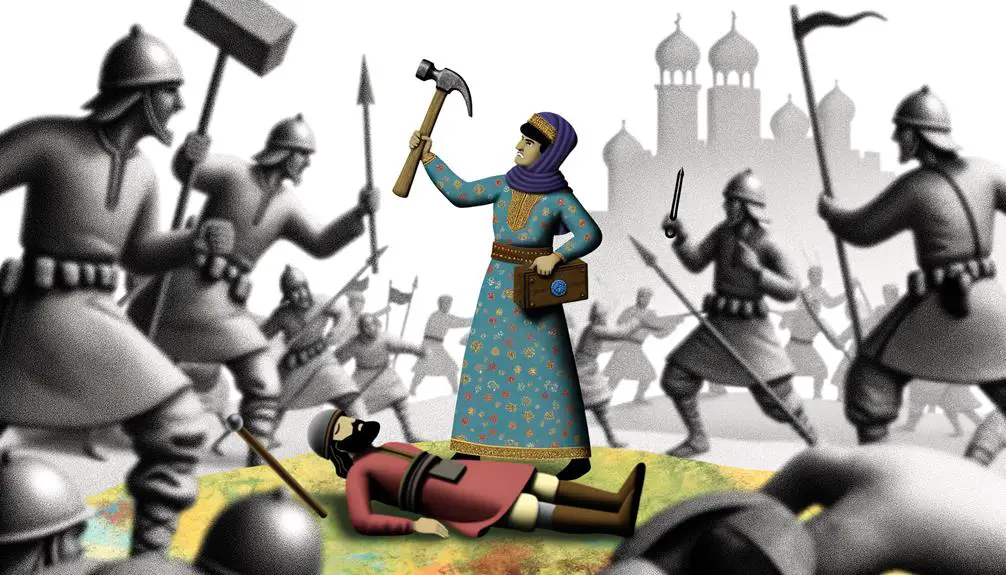
Throughout their history, the Israelites faced numerous conflicts that shaped their identity and beliefs. These conflicts weren't just physical battles but also spiritual and moral tests. Central to understanding these confrontations are the battle strategies they employed and the divine interventions they experienced. You'll see that the Israelites' approach to conflict was multifaceted, involving not only military tactics but also profound faith in divine support.
Conflict |
Battle Strategy |
Divine Intervention |
|---|---|---|
Against Amalekites |
Use of strategic positions |
Moses' prayers leading to victory |
Battle of Jericho |
Siege and ambush |
Walls collapsing after the Ark's procession |
Against Midianites |
Surprise attack at night |
Dream causing fear among enemies |
These examples illustrate how the Israelites' battle strategies were innovative for their time, often relying on elements of surprise and psychological warfare. Moreover, these strategies were frequently complemented by divine interventions. Whether through miraculous acts or bolstering the morale of the Israelite fighters, these interventions played a critical role in their victories.
This duality of reliance on both human ingenuity and divine assistance typifies the Israelite approach to conflict. It's a reflection of their covenant with God, where success in battle was seen as a sign of divine favor and approval. Analyzing these conflicts gives you insight into the complex relationship between the Israelites and their deity, a relationship that was both covenantal and conditional. It also underscores the importance of faith, leadership, and strategy in overcoming adversaries, themes that are recurrent in the narratives of the Hebrew Bible.
Sisera's Flight
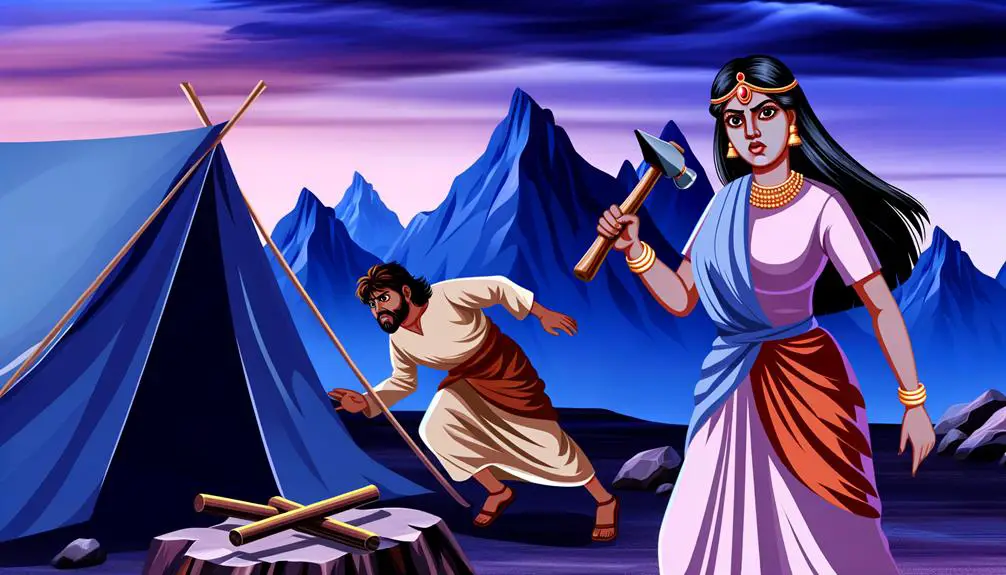
As you explore the narrative of Sisera's flight, it's crucial to consider the context and motivations behind his actions. Sisera's decision to seek refuge unveils layers of trust and desperation, while Jael's hospitable deception highlights the complexities of allegiance and survival in a time of conflict.
The culmination of these events with the fatal tent peg incident offers a poignant reflection on the themes of hospitality, betrayal, and the brutal realities of ancient warfare.
Sisera Seeks Refuge
Why did Sisera, the commander of King Jabin's army, seek refuge in Jael's tent during his flight from the Israelites? The reasons behind Sisera's choice are multifaceted, reflecting both his desperate situation and the cultural norms of the time:
- Sisera's downfall was imminent; his forces were scattered, and he was left vulnerable.
- Biblical hospitality norms dictated that seeking refuge in a tent could offer protection, as guests were traditionally safeguarded.
- He believed Jael's tent, being the tent of a woman, might be the last place his pursuers would search.
- The geopolitical alliances at the time made the tent of Heber the Kenite—a neutral party—a seemingly safe haven.
Sisera's decision to seek refuge highlights a complex interplay of desperation, cultural practices, and strategic miscalculation.
Jael's Hospitable Deception
Jael's act of offering refuge to Sisera, while seemingly hospitable, concealed a deadly intention that would decisively alter the course of the conflict. This moment presents a complex ethical dilemma, juxtaposing the expected sanctity of hospitality against the brutal realities of ancient warfare tactics.
Aspect |
Analysis |
|---|---|
Hospitality |
Used as a guise for strategic advantage. |
Ethical Dilemma |
Balancing moral codes with wartime necessity. |
Warfare Tactics |
Leveraging trust as a weapon. |
Deception |
A critical but contentious strategy. |
Outcome |
Changed the conflict's direction. |
Jael's actions force us to reevaluate the boundaries between right and wrong in war, highlighting the nuanced decisions individuals faced.
The Fatal Tent Peg
In a pivotal moment that would seal the fate of Sisera, he sought refuge in the tent of Jael, unknowingly stepping into a trap that would lead to his demise. The account raises several points of interest:
- Tent peg symbolism: The use of a domestic tool as a weapon underscores the theme of the unexpected in divine deliverance.
- Ethical debates: Scholars ponder the morality of Jael's act, given the hospitality norms of the time.
- Role of women: Jael's decisive action challenges traditional gender roles, highlighting female agency.
- Divine intervention: The incident is often interpreted as divinely orchestrated, aligning with the theme of God working through unexpected means.
This episode invites reflection on the complexities of moral judgment and the instruments of divine will.
Jael's Hospitality
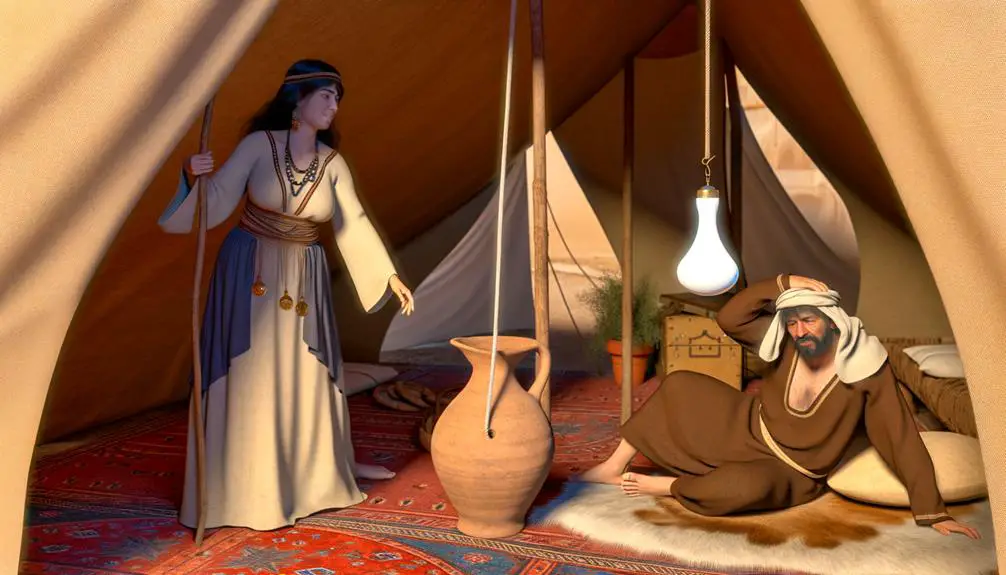
Upon entering her tent, Sisera found not only refuge but also an unexpected display of hospitality from Jael, who offered him milk instead of water, a gesture rich in cultural significance. This act is not merely a detail in the narrative but a window into the domestic customs and women's roles in ancient societies. Jael's hospitality, while appearing generous and nurturing, also positions her within the expected gender roles of her time, where women were often the caretakers and providers of sustenance within the domestic sphere.
Cultural Significance |
Implications |
|---|---|
Offering Milk |
Beyond mere sustenance, offering milk instead of water was a sign of special hospitality and respect. |
Women's Roles |
Reflects the expectation for women to be caretakers and to manage the domestic sphere, including the reception of guests. |
Domestic Customs |
Jael's actions echo broader domestic customs where the provision of food and drink was a critical aspect of hospitality. |
Gender Expectations |
Her actions subtly reinforce the gender expectations of her time, despite her later subversive act. |
Societal Norms |
This episode underscores the importance of hospitality in ancient societies, where such acts could define social relationships and alliances. |
Jael's engagement with these domestic customs and the fulfillment of her role within them offers a nuanced understanding of her character. It's essential to recognize the complexity of her actions, which, while rooted in the norms of her time, also set the stage for her later, more revolutionary act. This interplay between adherence to societal expectations and individual agency provides a rich framework for understanding Jael's story in the broader context of women's roles in the Bible.
The Act of Courage
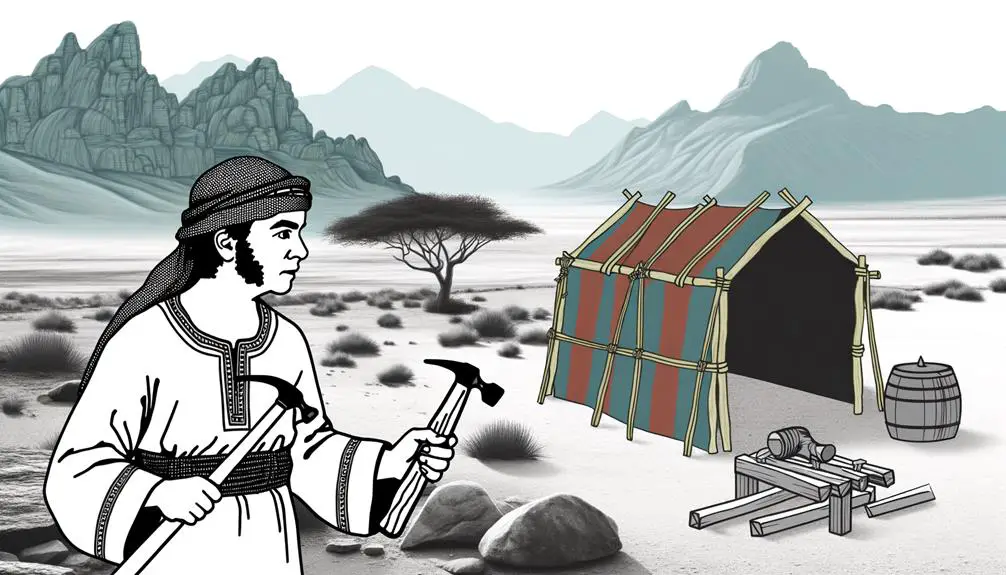
While Jael's hospitality conformed to societal expectations of women, her next actions showcased a remarkable departure through a bold act of courage. This moment not only disrupts traditional gender roles but also plunges us into a complex web of ethical dilemmas. Here, you're witnessing a pivotal point where courage interlaces with controversy.
- Courage in Defiance of Gender Norms: In the narrative, Jael steps outside the prescribed female domain, both literally and metaphorically. Her actions challenge the prevailing gender roles of her time, illustrating that courage and leadership aren't confined to one gender. This defiance raises questions about the rigidity of societal norms and the potential for their evolution.
- Ethical Dilemmas: Jael's act of courage brings forth a myriad of ethical dilemmas. While her actions can be seen as heroic, saving her people, they also involve deception and violence, complicating the moral assessment of her deed. This duality prompts a deeper reflection on the nature of ethical decision-making in dire circumstances.
- Strategic Boldness: Beyond the aspect of courage, Jael's actions demonstrate a keen strategic acumen. She seizes a critical opportunity to shift the balance of power, indicating that courage isn't only about bravery but also about the wisdom to act decisively at the opportune moment.
- Legacy of Courage: Jael's story leaves a lasting legacy on the discourse of courage, gender roles, and ethical dilemmas. Her narrative invites ongoing discussion about the complexities of moral courage and the ways in which individuals navigate the intricate interplay of societal expectations and personal convictions.
In analyzing Jael's act of courage, it becomes evident that her story transcends mere historical recounting, offering rich terrain for the exploration of gender, ethics, and the multifaceted nature of human courage.
The Aftermath
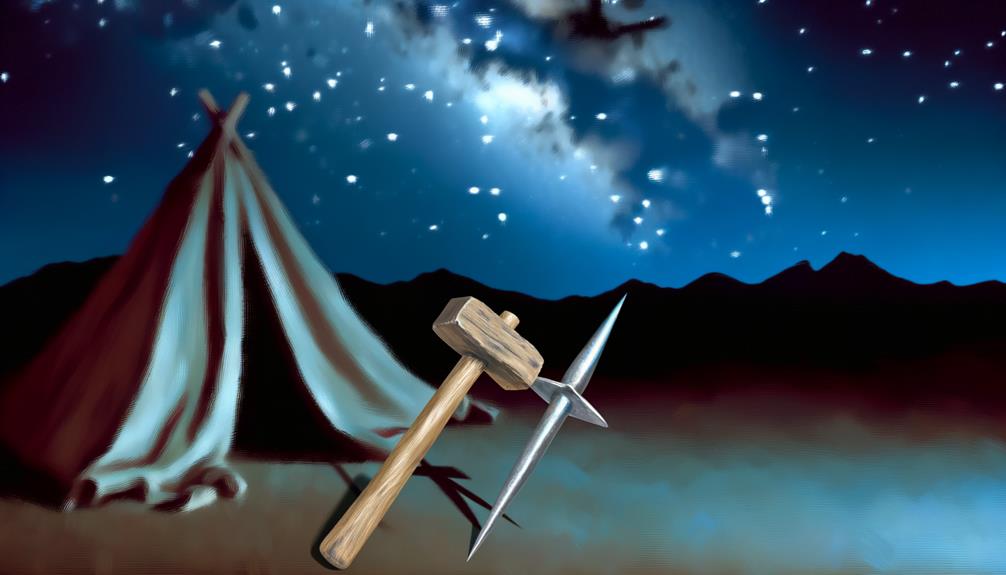
Jael's decisive action not only shifted the power dynamics of her time but also set the stage for a profound reevaluation of gender roles and ethical frameworks in historical and contemporary discourse. The moral implications of her deed are complex, navigating the murky waters between treachery and heroism, deceit, and deliverance. You're invited to consider not just the act itself but the broader context in which it unfolded, exploring how it challenges or reinforces societal norms and expectations.
The narrative surrounding Jael significantly contributes to the discourse on gender roles within biblical and secular societies. Her actions defy traditional gender expectations of the time, presenting a powerful female figure who decisively influences the course of a nation's history. This departure from normative gender roles raises questions about the flexibility and adaptability of these roles across cultures and epochs.
Moreover, the moral implications of Jael's actions are subject to scrutiny. You're prompted to examine the ethics of her methods, weighing the necessity and justification of her actions against the backdrop of war and survival. This analysis reveals the nuanced considerations of moral philosophy within historical and religious contexts, encouraging a balanced understanding of right and wrong in complex situations.
Jael's Legacy
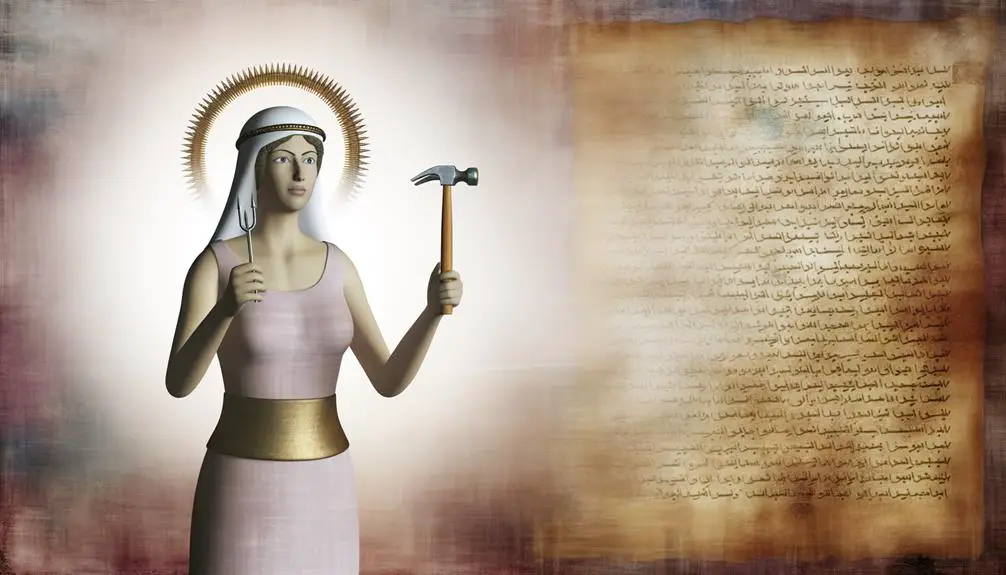
Reflecting on the story of Jael, it becomes evident that her legacy is woven into the fabric of cultural and theological discussions, challenging traditional narratives and inviting a reexamination of heroism and morality in ancient texts. Her actions provide a complex tableau for examining gender roles and the ethical ambiguity inherent in her story.
- Gender Roles: Jael's narrative disrupts conventional gender expectations of the biblical era. Typically, women in ancient texts occupy passive roles, but Jael's decisive action in killing Sisera positions her as an active agent of change. This challenges readers to reconsider the roles women play in both historical and contemporary narratives, highlighting the fluidity and complexity of gender roles over time.
- Ethical Ambiguity: The moral implications of Jael's deed offer no clear resolution, presenting a case of ethical ambiguity that stimulates debate. Was her act a divine intervention, justified by the context of war, or was it a breach of hospitality, a fundamental value of her time? This question encourages a nuanced consideration of ethics and morality in historical and religious contexts.
- Theological Reinterpretation: Theological discussions around Jael often highlight her as a figure of divine justice, suggesting that her actions were guided by a higher moral authority. This interpretation prompts a reevaluation of divine will and human agency in biblical stories, offering a space for diverse theological perspectives.
- Cultural Influence: Jael's story has permeated various cultural expressions, from classical art to contemporary feminist discourse, underscoring her lasting impact. Her legacy invites ongoing dialogue about the intersection of faith, gender, and morality, ensuring her place in both scholarly and popular discussions.
Frequently Asked Questions
How Does Jael's Story Compare to Modern Feminist Interpretations of Biblical Women?
You're exploring how Jael's story is perceived through modern feminist lenses, focusing on gender empowerment and narrative authority.
This analysis delves into the reclamation of biblical women's narratives, positioning Jael not just as a figure in a patriarchal text but as a symbol of female strength and autonomy.
Scholars argue that such interpretations offer a richer, more nuanced understanding of biblical stories, challenging traditional readings and highlighting women's roles in these ancient narratives.
What Are the Ethical Implications of Jael's Actions From a Contemporary Perspective?
From a contemporary perspective, Jael's actions present moral ambiguity.
You're confronted with the challenge of reconciling her deeds with modern ethical standards, juxtaposed against a backdrop of divine intervention.
This scenario invites you to critically analyze the intersection of faith, morality, and individual action.
It's essential to navigate these complex waters with an open mind, recognizing the historical context while pondering the broader implications of such actions in today's ethical landscape.
Are There Any Archaeological Evidences or Historical Findings That Corroborate the Story of Jael?
You're likely wondering if there's solid proof backing the tale you're curious about. When diving into excavation challenges and artifact authentication, you'll find that the archaeological community faces hurdles in directly tying findings to specific narratives.
While intriguing artifacts and sites from the relevant era exist, linking them conclusively to the story proves difficult. Scholars continue to analyze and debate the evidence, maintaining an unbiased, analytical stance toward interpreting these historical puzzles.
How Has Jael Been Portrayed in Classical Art, Literature, and Music Throughout History?
You're exploring how Jael's story has been immortalized in classical representations across art, literature, and music.
These artistic interpretations weave a tapestry of emotion and perspective, shedding light on her character in ways that words alone cannot.
Scholars have dissected these portrayals, offering an analytical and unbiased view that enriches our understanding.
From Renaissance paintings to operatic scores, Jael's tale has been a muse for creativity, echoing through the annals of history.
What Role Do Gender Dynamics Play in the Reception and Interpretation of Jael's Story in Different Religious Traditions?
You'll find that gender dynamics significantly influence how Jael's story is received and interpreted across different religious traditions. Cultural perceptions and religious symbolism often dictate the narrative's frame, leading to varied understandings and teachings.
This variation underscores the complexity of reading ancient texts through modern lenses. By analyzing these dynamics, you gain insight into not only the story itself but also the broader context of gender roles within religious storytelling.
Conclusion
In the biblical narrative, Jael emerges as both hostess and warrior, juxtaposing the roles of nurturer and destroyer. Her act of driving a tent peg through Sisera's skull, while initially appearing as a breach of hospitality, reveals a deeper commitment to divine justice over societal norms.
This duality underscores the complexity of moral choices in times of conflict. Jael's legacy, therefore, isn't merely one of violence, but of courage and decisiveness in the service of her people's liberation.

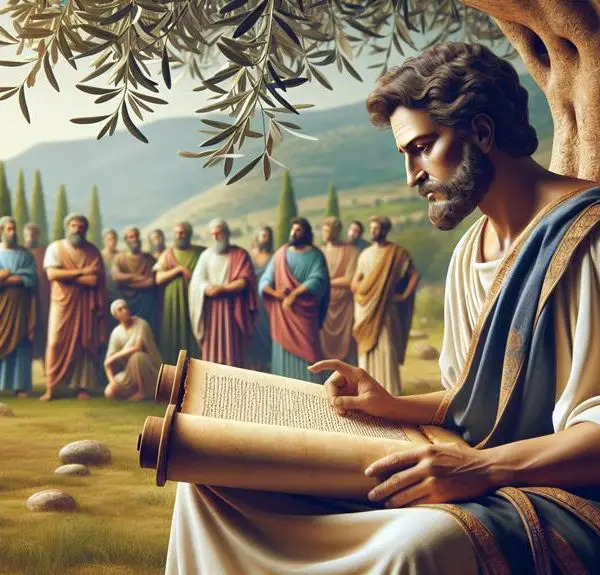
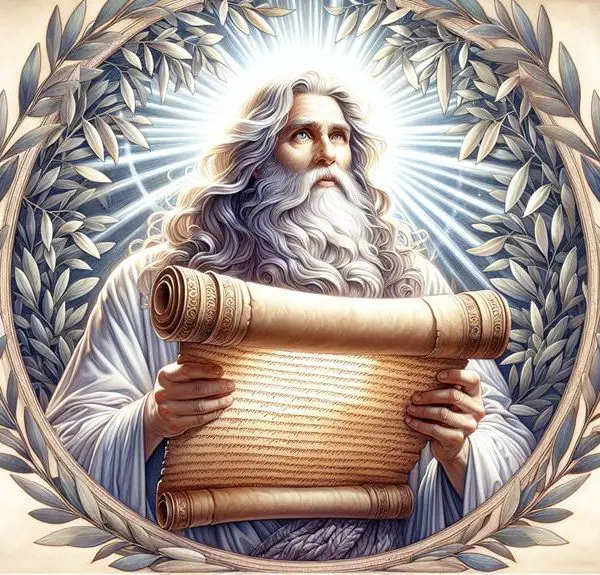
Sign up